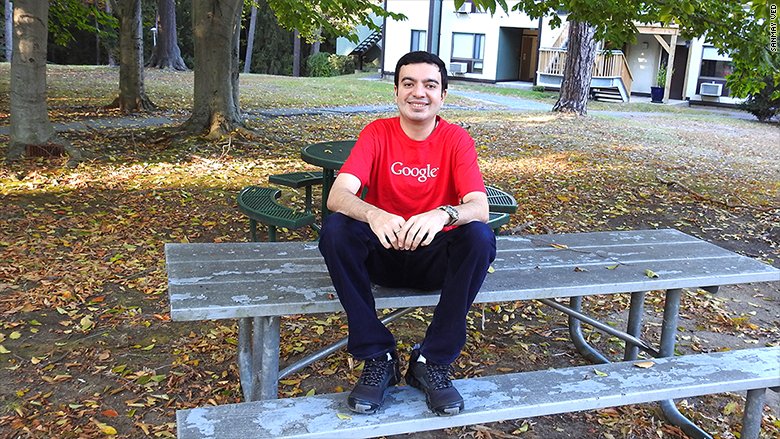1. Google.com for Sale
This is very interesting fact that when in 2015, an Indian bought Google.com for just INR 800. Yes, the real Google.com, which is the world’s most visited website. Now, he could’ve become a millionaire. But he gave it back to Google. And that too, for free.
Sanmay Ved, who was a former Google employee, was casually exploring domains one night. And then he saw that Google.com was available for just $12, which was around INR 800 at the time.
So he quickly added it to the cart and checked out. And his screen read: “You now own Google.com.” For a whole one minute, Sanmay was the owner of the most powerful domain in the world.
But he didn’t run any scams or demand any money. He contacted Google himself and returned the domain. Now this impressed Google. They said, “We’ll give you a reward”—a total of $6006.13, because in leetspeak, Google is written that way.
But here comes the biggest twist, Sanmay refused the reward. He said, “Donate this amount in the name of Indian kids who can’t afford to go to school.”
Now how could Google say no to that? So not only did they donate it, they doubled the amount and donated it to the Art of Living Foundation, which runs over 1300 free schools in India.
Sanmay had the power. He had a golden chance to make a profit. But instead, he created a legacy. He turned Google’s mistake into a better future for others. Taking the right decision at the right time, that’s what real business is about.

2. Interesting fact how To Enhance Memory
There is a beach in Scotland called Oban, where, in 1934, an American ship sank. Today, coral reefs have formed around this ship. Octopuses swim there, fish swim by vibrant, colorful fish.
But this place didn’t become famous because of the ship. It became legendary because of an experiment on how we learn.
Two psychologists brought 18 students to this beach. They made them wear scuba diving suits and dive 20 feet underwater. While they were underwater seeing fish swimming around, hearing the sound of their oxygen breath, feeling the weight of the oxygen tank on their shoulders at that very moment, they were given a list of 36 words to study look once, look twice, look three times.
Then they were brought back to dry land. An hour later, half of them (9 students) were asked to put the suit back on and dive again, while the remaining 9 were told to stay on land.
Both groups were asked to recall the words.
Who do you think remembered more? The ones who went back into the same environment, under 20 feet of water, remembered 28 out of 36 words on average.
The ones who stayed on land remembered only 18 out of 36.
This changed the way we look at learning forever.
When we form memories, they’re not isolated—they’re woven into our surroundings, just like fabric is made of different threads. Perhaps it was the bubbles from the oxygen tank, or the sight of the octopus swimming by, or the weight of the tank on their shoulders, all of these helped them recall better.
This experiment was repeated around the world for example, in classrooms, where the same class teacher who taught the subject was made the exam invigilator. Just by seeing a familiar face, students’ marks increased by 10% because their confidence was boosted.
So prepare your memory by being fully present in the environment engage, imagine, immerse and you’ll remember more.

3. Interesting fact about invention of stethoscope
Today, the stethoscope that hangs around every doctor’s neck its origin began with just a sheet of paper.
Dr. René Laennec was examining a young girl who had a heart problem. At that time, there was only one method to check the heart placing the ear directly on the chest to listen.
Laennec found this approach a bit uncomfortable especially because the patient was a young girl, and he himself was a very modest person.
Then he remembered something sound can travel through wood. Like when you place your ear on a ruler and scratch the other end, you can hear the scratch through the ruler.
In that moment, he didn’t have wood, but he had paper. So he rolled a sheet of paper into a tube, placed one end on the chest and the other on his ear and it worked.
He was able to examine his patient in a way that felt dignified to both. And this became the world’s first prototype of the stethoscope a wooden tube-like cylinder approximately 25 cm long.
Laennec named it “The Cylinder.” Later, he refined this idea and in 1819, he published a book titled “Treatise on Mediate Auscultation”, which systematically studied the sounds of the heart and lungs.
This was a turning point in modern diagnosis. Heart murmurs, chest congestion, and lung function could now be understood without physically touching the patient.
The stethoscope wasn’t invented in a high-tech lab but in a moment where a doctor found a solution between respect, comfort, and diagnosis.

4. invention of chainsaw
Today, the chainsaw that is used to cut trees was originally invented to make childbirth easier. Just hearing that sounds shocking imagine what the experience must have been like.
Around 1780 in Scotland, two doctors, John Aitken and James Jeffray, wanted to create a surgical tool to help deliver babies who were stuck during childbirth. At that time, when a baby got stuck in the pelvis, doctors performed a procedure called symphysiotomy or sometimes a cesarean. Symphysiotomy was a very painful procedure in which the pubic bone was cut to enlarge the birth canal so the baby could come out more easily. Doing this with a scalpel was extremely difficult. Just imagine cutting bone with a blade.
So Aitken and Jeffray invented a hand-cranked, chainsaw-like device called an osteotome. It provided faster and more precise cutting and served its purpose in medical use. However, the symphysiotomy procedure itself was such a traumatic and painful experience that as soon as C-sections began to be done more safely using antiseptic techniques, symphysiotomy was discontinued and with it, the osteotome disappeared from medical rooms.
But no invention ever truly goes to waste especially if it’s functional. The chainsaw was a functional concept, which may have started in the wrong place but eventually evolved to the right one.

5. Interesting fact about the beaver, the engineer of jungle
Did you know its teeth are so sharp that it can cut down up to 2,600 trees in its lifetime?
But the question is—why does it cut trees? Certainly not just for fun. To build dams. The beaver builds dams out of wood and mud to block water.
But why are dams so important? Because that’s where it lives. That’s where it stores food, and that’s what protects it—from the cold and from predators.
Now listen to something amazing: The largest beaver dam ever recorded was 850 meters long. So big that it can be seen from a satellite!
Now think if its dam breaks, does the beaver give up? Not at all!
The beaver can rebuild the entire dam in just one night.
And wherever beavers build dams, trees, plants, birds, and fish all thrive.
The whole biodiversity flourishes.
So the beaver just an animal but a nature’s real hero

Thank you for reading.
Some parts of this article were written using AI to organize the information more efficiently.
You can also read:
- The top 20 Innovative AI Announcements by Google I/O- 2025
- Artificial Intelligence and Warfare
- A shared history lingering rivalry and lost opportunities
- NFL vs. IPL

I have been absent for some time, but now I remember why I used to love this web site. Thanks , I will try and check back more frequently. How frequently you update your site?
o2cb79